This post contains affiliate links. Please see our disclosure policy.
If you are here, you are looking to tackle one of the hardest things a backyard pitmaster can do… smoking a whole packer brisket! Time and patience are necessities to success here. If you practice both, you too will turn out an amazing brisket!
A “whole packer” brisket comprises two muscles that sit on top of one another separated by a layer of fat. The flat (pectoralis profundus) is lean and more rectangular in shape. The point (pectoralis superficialis) is fatty and looks like a bulging mound of meat sitting on top. You can easily find brisket flats at most grocery stores, but for central Texas style barbecue, you want a “whole packer” brisket. What makes this central Texas style BBQ is the magic of this recipe. This brisket recipe uses a simple seasoning mix and post oak wood to flavor the meat. After 10-14 hours in your smoker, this will be the best BBQ by far you have ever cooked. Now sit back, grab an ice cold Shiner Bock, and enjoy this post How to Smoke a Brisket on the Big Green Egg
Trimming The Brisket
Start with your whole packer brisket sitting on a cutting board fat side down. Trim off all the excess fat, hard fat, and silver skin.

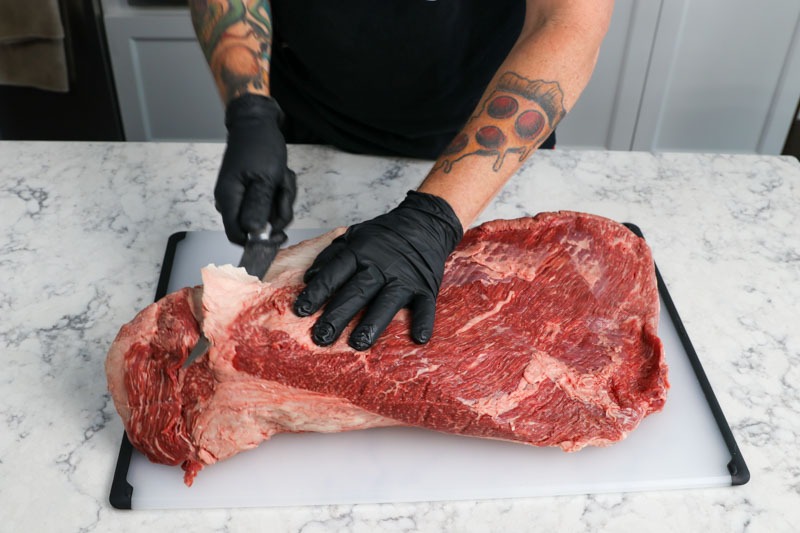
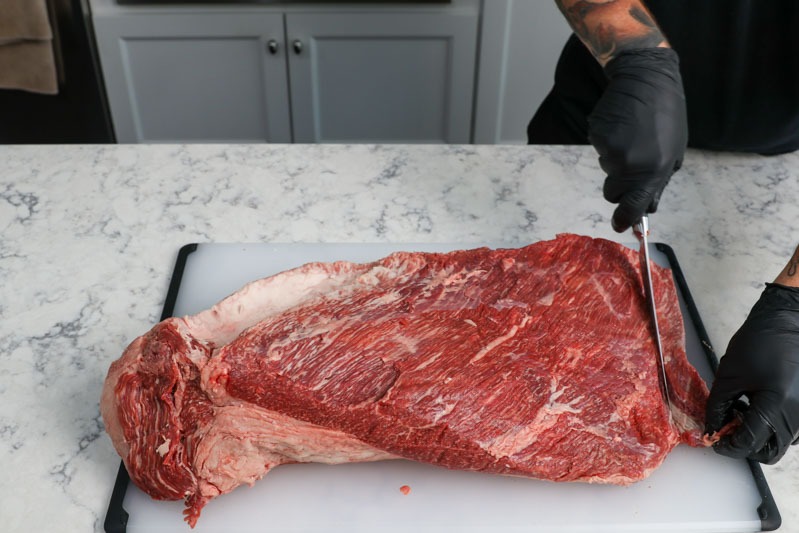
Now flip the brisket over and trim the fat cap down to a 1/4″ thick.
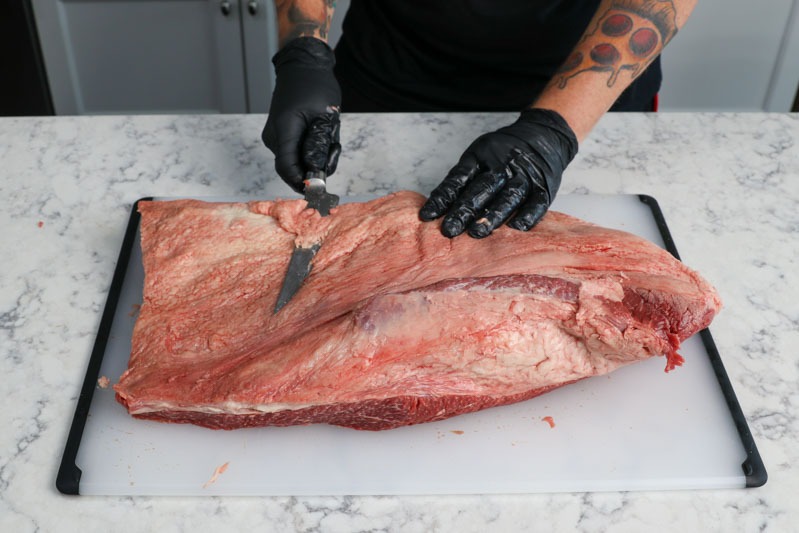
Use a little yellow mustard to act as a binder for the seasoning. Rub that all over the top and bottom of the brisket.

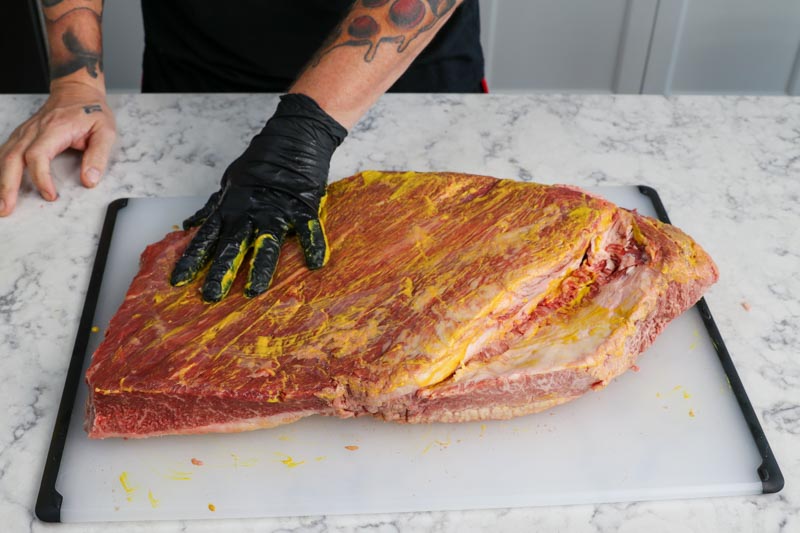
Now season liberally the top and bottom of the brisket with your spice mixture.
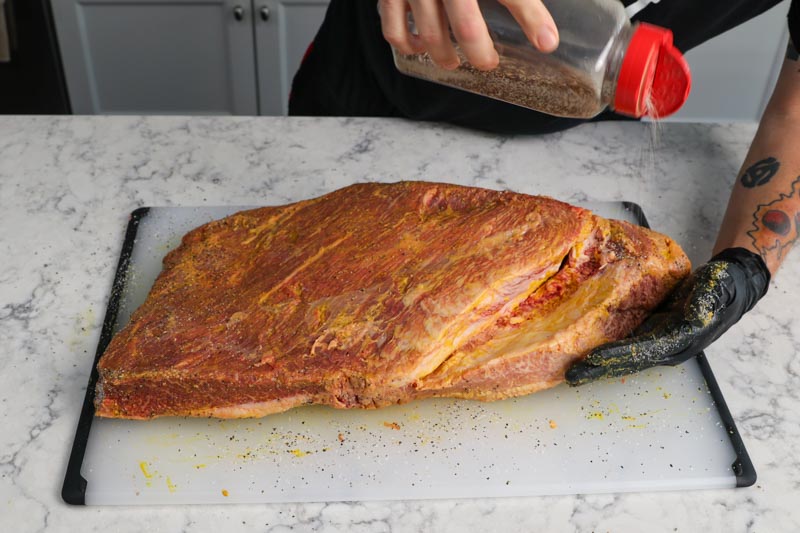
Let the brisket sit at room temperature while you setup and light your Big Green Egg.

Setup and Lighting the big green egg
Fill the firebowl of the Big Green Egg up with a layer of lump charcoal. Next place 4 – 5 chunks of Oak smoking wood. Fill the rest of the firebowl up with lump charcoal and start your fire. If you need a refresher course on how to do this, check out my post for How to set up your Big Green Egg for Low and Slow Cooking. Preheat the Big Green Egg to 250°F, place in your ConvEGGtor (or 2 half moon ceramic stones if using EGGspander
base), and wait for the smoke to turn to a light blue/gray color.
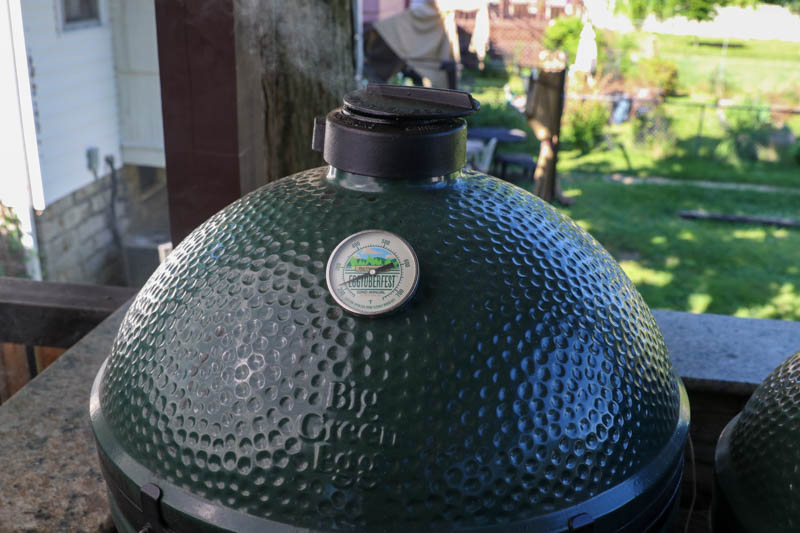
Smoking the brisket
Once the temperature is stable at 250°F and the smoke is clean, place your brisket inside. I like do 2 things when smoking a brisket on my Big Green Egg: First, I place a small lump of smoking wood on the grate and place the brisket on top of that so the brisket bows. This allows the fat and moisture to run off the surface of the brisket preserving the bark. I got this tip from Henry Soo at Slap Yo’ Daddy BBQ. Second, I use a 1/4 steam table pan filled with warm water to keep the environment nice and humid for this long cook.
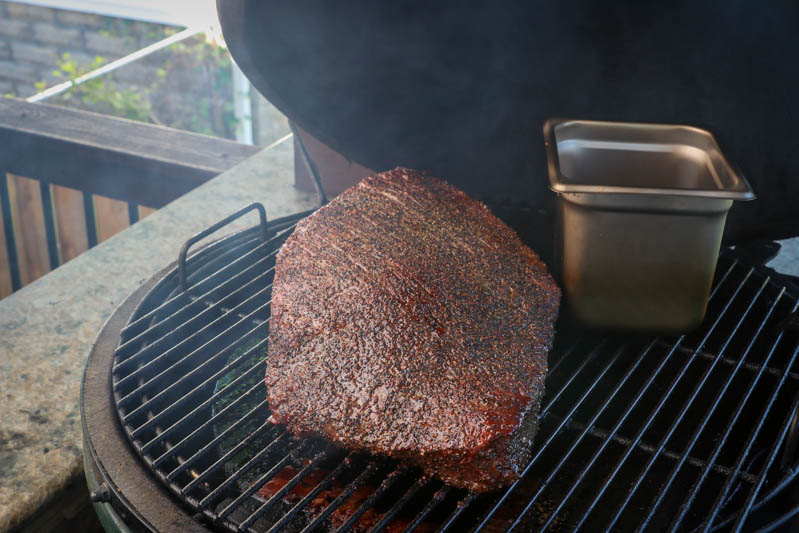
Spritzing the brisket
After the first 3 hours of the smoke, start spritzing the brisket every 45 minutes when you see dry spots forming.
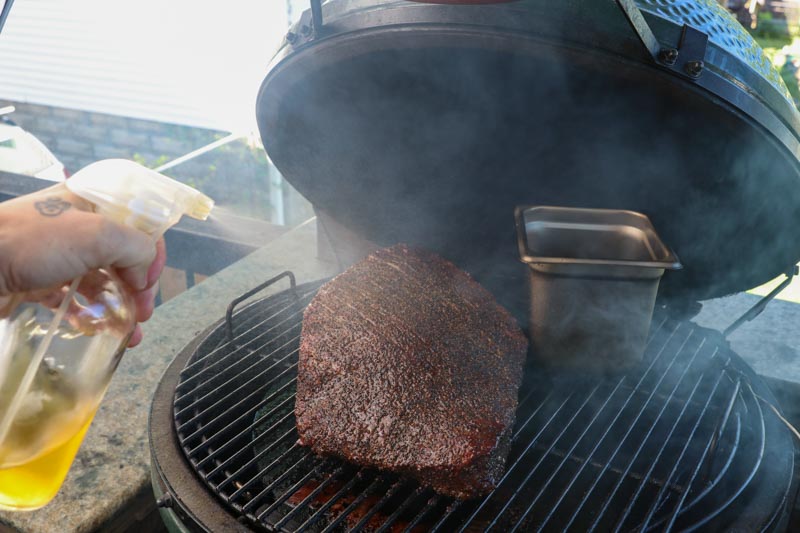
When the bark is set and the stall has started to break (typically 5-6 hours in to the cook and 165°F internal temperature) pull the brisket and wrap it.
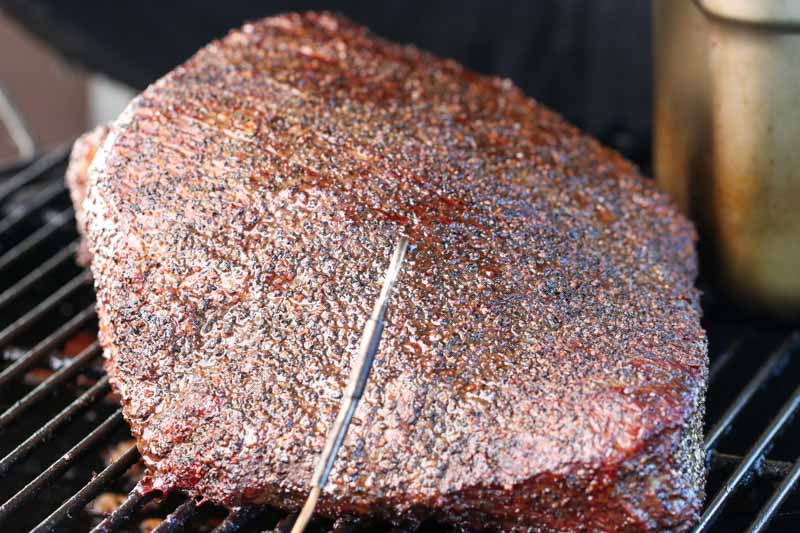
wrapping the brisket
When you remove the brisket from the Big Green Egg, have two pieces of butcher paper roughly 30” long a piece overlapping and set aside for you to place the brisket on.
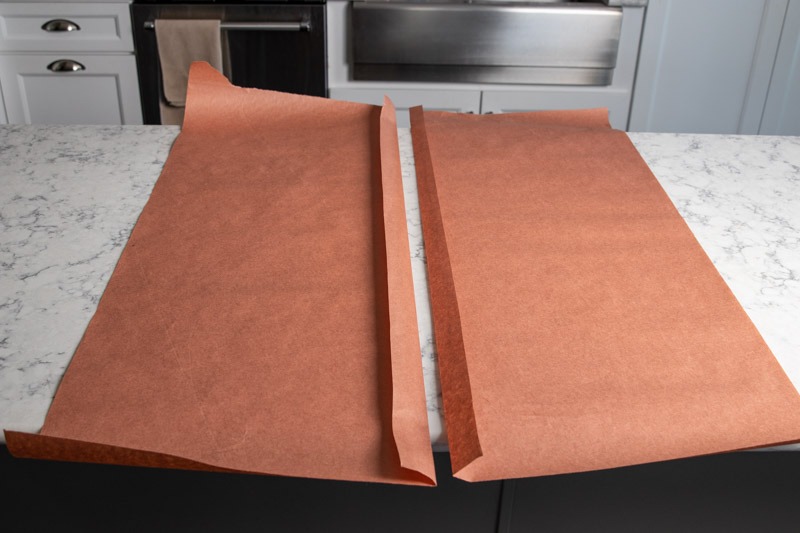
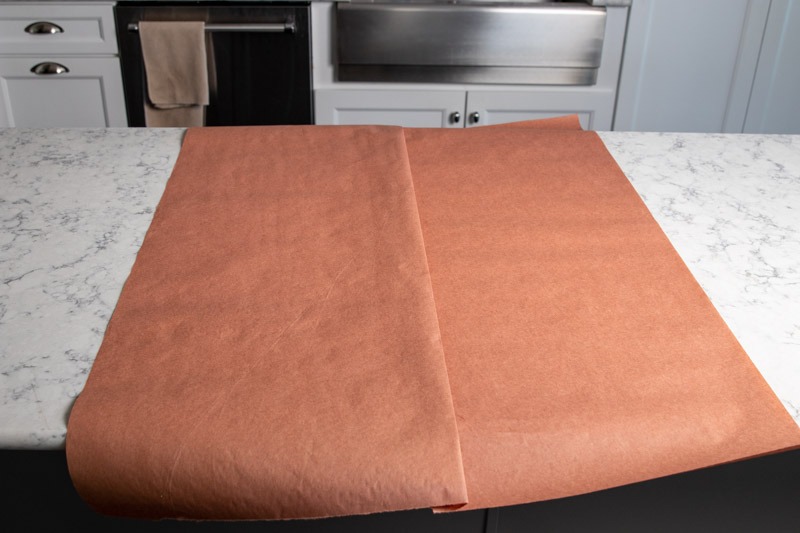
Place the brisket about 1/3rd of the way up the overlapping butcher paper and spritz one more time with water. Add a few shakes of the spice mixture to the surface of the meat then wrap the brisket up in the paper.
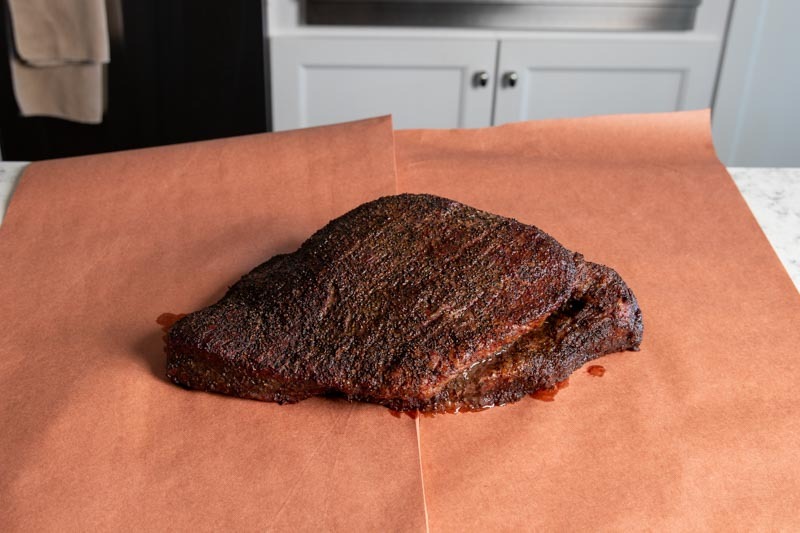

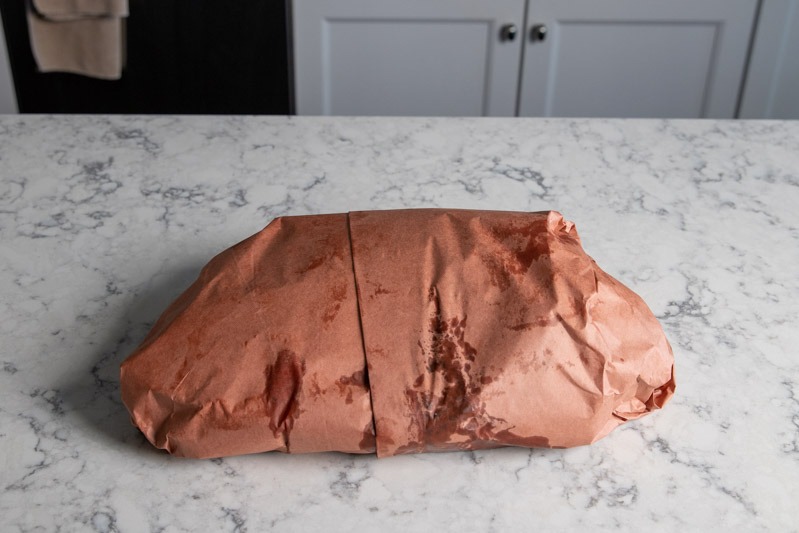
finishing the brisket
Placed the wrapped brisket back in the Big Green Egg and let it continue to cook. From this point, it is a waiting game as the brisket will rise in temperature from 170°F to 190° – 210°F.
Here are the cues to look for with the actions to take letting you know when the brisket is ready to come off the Big Green Egg:
Temperature: brisket is two muscles joined together with a thick layer of fat. One muscle is large and fatty while the other is long, flat and lean. Both muscles will not reach temperatures at the same time. So, I like to take my cues from the flat as that is the hardest part to get right. Once your flat starts measuring 190° to 210° you are ready to move on to the final test to know if the brisket is done.
Feel: now that your flat is measuring between 190° – 210°, use the thermometer probe to check the flat and point for tenderness. You want the thermometer to go in and out of the brisket with little to no resistance. Think of it like poking a bag of mashed potatoes. That probe needs to slide in and out with ease. If you do not feel that, leave the brisket in your smoker and check every 30 minutes until that is the texture you feel when taking the temperature. Once you get that you are done but you are not ready to eat yet. Remove the brisket from the smoker and get ready for it to rest.
resting the brisket
Now that the brisket is off the Big Green Egg, wrap it in plastic wrap, wrap that in an old towel, and place it in an empty cooler (e.g., Yeti) for 1 – 4 hours. This resting is a key step to getting your brisket as juicy as possible. As the brisket rests, all the rendered fat and collagen released during the long cook settles and redistributes through the meat. Please let this rest before serving, you will thank me later.
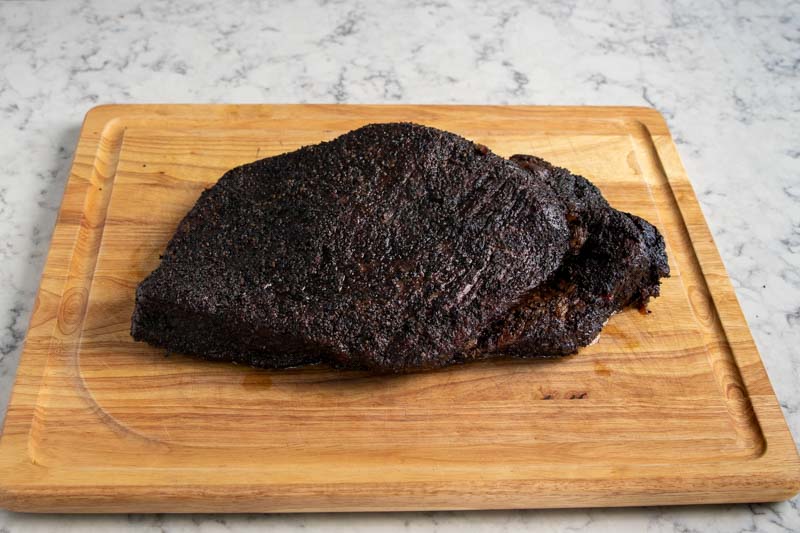
Slicing the brisket
Finally, take the brisket out of the cooler and wrapping then place it on a cutting board. Separate the point from the flat by cutting through the deckle (fatty layer between each muscle). Now slice the flat in to pencil thin slices and the point can be cubed for burnt ends or slice against the grain for juicy fatty slices of brisket deliciousness.
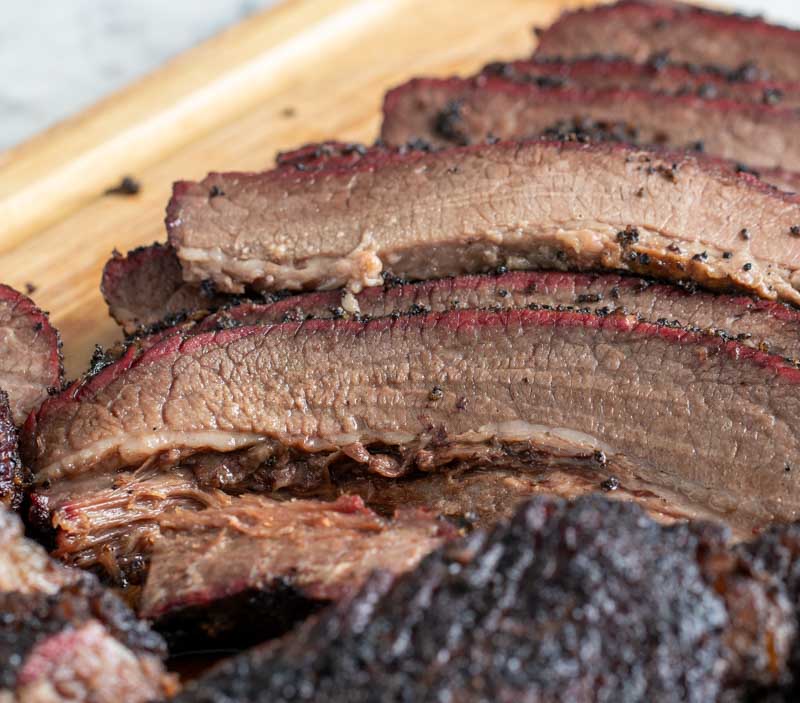
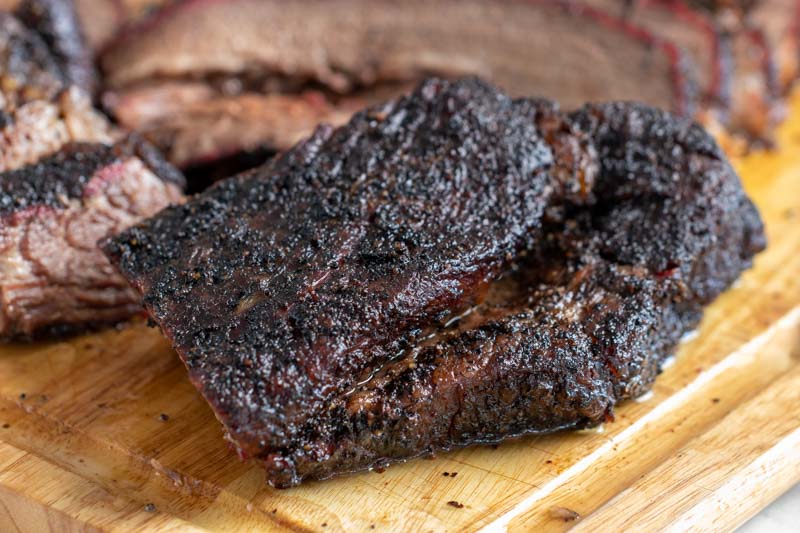
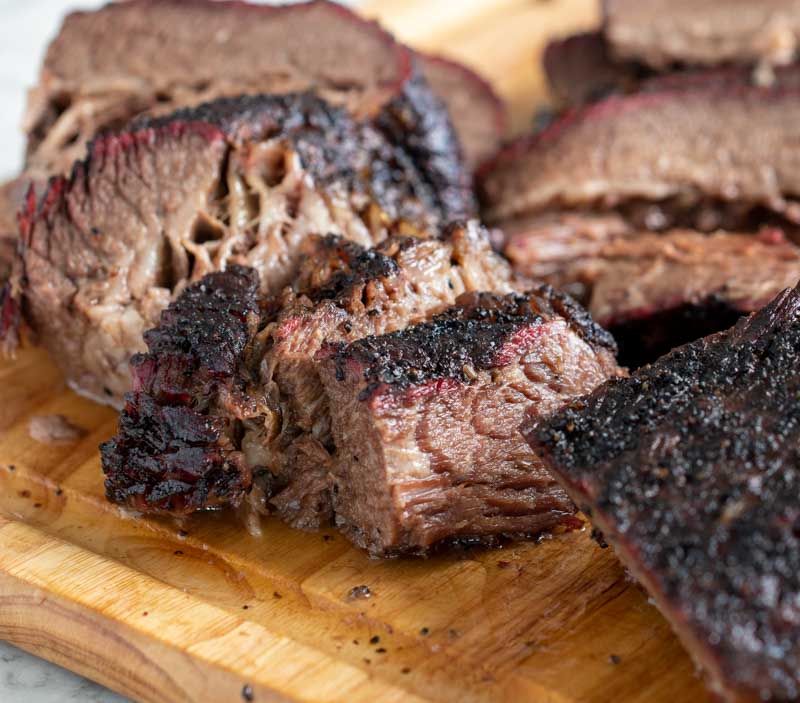
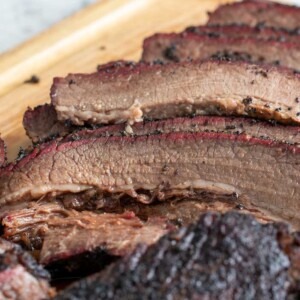
How to Smoke a Brisket on the Big Green Egg
Ingredients
- 12-15 lb whole packer brisket
- 1 tbsp mustard
- ½ cup cracked black pepper
- ¼ cup Lawry’s Seasoned Salt
- ¼ cup kosher salt
- 1 cup beef broth
Instructions
- Trim the fat cap of the brisket down to ¼”. Trim the large chunk of hard fat that sits between the point and flat muscles on the meat side of the brisket. Trim the sides and ends to be uniform in shape. Add the mustard to the entire surface of the brisket creating a light slather for the spices to adhere to. Mix together the Kosher Salt, Lawry’s Seasoned Salt, and cracked pepper together in a shaker. Now, shake the spice mix evenly across all surfaces of the brisket. Let the meat sit out at room temperature for at least an hour before putting it on the smoker (this allows the meat to start cooking faster at the lower temperature. If you put a large cut of meat like this in the smoker cold, it will add up to an hour or more to your total cook time).
- Load the lump charcoal, light a small fire, set temperature to 250°F and add 2-3 chunks of smoking wood (preferably Hickory or Post Oak). In kettle smokers you will need to add a water pan to help keep humidity at that 70%-80% range. A Big Green Egg is so well insulated that you do not need to add a water pan to help manage humidity.
- Once you see the smoke turn from white to blueish gray, it is time to put your meat inside. Place the brisket fat side down in the Big Green Egg. The fat cap renders slowly during the long cook and will act as a barrier between the meat and the heat source helping to keep surface area from drying out. There is much debate on fat side up or down. For me, it depends on which cooker you are using. I have found when the heat source is below the meat, fat side down is the way to go.
- For the first 3 hours of the brisket cook, leave the brisket alone. Do not open the Big Green Egg for any reason. This first phase is where the pellicle is forming, and the most important smoke absorption occurs. After 3 hours that’s when the fun begins.
- As you are waiting to check in on the brisket after the 3-hour mark, now is the time to prepare a spray bottle to mist the brisket with for the next part of the cook. Fill your spray bottle with 3 parts water, 1 part apple cider vinegar, a dash of Worcestershire sauce, and a dash of your favorite hot sauce.
- Once you have made it through the first 3 hours of the cook you should have decent color forming on the outside of the brisket. You want to ensure your pellicle is not too dry or too wet. At this part of the cook, you may need to spray the outside of the brisket with the spritz mixture. To know, look inside the Big Green Egg and touch the surface area of the flat part of the brisket with your fingertip. Do not move or pick up the brisket as you do not want to interrupt the bark formation. You want the surface to be slightly sticky to the touch but not wet. If it is dry and streaky, spray the surface with a spray bottle full of the mixture. This will help the formation of the bark more than anything else. At this stage in the cook, most if not all of the smoke flavor has been absorbed into the meat. But the gases and oils being released from the wood smoldering inside the firebox need to adhere to the surface of the meat in order to form that dark color you want. To ensure that happens, making sure the surface area stays moist is key. You will want to do this every 30 minutes or so until you wrap the brisket after it breaks stall.
- Brisket is a very large, dense cut of beef. Over time as it cooks slowly inside the Big Green Egg, the fat and collagen break down releasing liquid. After 4 – 5 hours of total cooking time, the internal temperature will stick at one spot usually between 150° and 160°F. This temperature “stall” can last several hours and be frustrating. I suggest using a digital instant read thermometer to check the temperature of both the point and flat muscles. Make sure you are not putting the tip of the thermometer into the deckle (fat layer) as that will not give you accurate results. The best time to check the temperature is when you are looking at the brisket’s bark formation every 30 minutes or so. Open your Big Green Egg, observe the bark formation, take a temperature and note the changes.
- NOTE: My guidance to you is wait until the brisket breaks stall i.e. the temperature starts rising again before wrapping. In my experience, wrapping is not designed to break the stall but rather help tenderize the meat in the finally stages of the cook. Waiting until stall is broke helps you develop that deep, rich and dark bark you want.
- Once the internal temperature starts climbing by more than a degree from the stalled temperature, and your bark is a dark mahogany color and not streaking when you mist it, it is time to take off the Big Green Egg and wrap.
- You have a choice at this point to wrap in aluminum foil or butcher paper. To be direct, I have had success with both methods. However, I usually wrap in butcher paper now as it gives you a slight advantage to bark formation. Basically, paper allows the steam inside to release without getting trapped inside. This helps the bark get darker and provides the texture you want. Wrapping with foil usually speeds up the time to get the brisket probe tender but can impact bark formation. That is why most pit masters today wrap with the butcher paper. When you remove the brisket from the smoker, have two pieces of butcher paper roughly 30” long a piece overlapping and set aside for you to place the brisket on. Place the brisket about 1/3rd of the way up the overlapping butcher paper and spritz one more time with water. Add a few shakes of the spice mixture to the surface of the meat then wrap the brisket up in the paper. Place the wrapped brisket in a large aluminum pan with a cup of beef broth in the bottom. Place the pan with the brisket back in the smoker and let it cook until it is done.
- From this point it is a waiting game as the brisket will rise in temperature from 170°F to 190° – 210°F. Here are the cues to look for with the actions to take letting you know when the brisket is ready to come off the cooker:
- Temperature: brisket is two muscles joined together with a thick layer of fat. One muscle is large and fatty while the other is long, flat and lean. Both muscles will not reach temperatures at the same time. So, I like to take my cues from the flat as that is the hardest part to get right. Once your flat starts measuring 190°F to 210°F you are ready to move on to the final test to know if the brisket is done.
- Feel: now that your flat is measuring between 190° – 210°F, use the thermometer probe to check the flat and point for tenderness. You want the thermometer to go in and out of the brisket with little to no resistance. Think of it like poking a bag of mashed potatoes. That probe needs to slide in and out with ease. If you do not feel that, leave the brisket in your smoker and check every 30 minutes until that is the texture you feel when taking the temperature. Once you get that you are done… but you are not ready to eat yet. Remove the pan with the brisket from the smoker and get ready for it to rest.
- Now that the brisket is off the Big Green Egg, wrap it in plastic wrap, then wrap that in an old towel, and place it in an empty cooler for 1 – 4 hours. This resting is a key step to getting your brisket as juicy as possible.
- NOTE: I say 1 – 4 hours as the longer the brisket rests, the more the juices settle, and the collagen breaks down. The sweet spot for most people is 2 hours but you can wait and extra 2 as needed if it accommodates your serving time.
- Finally, take the brisket out of the cooler and wrapping then place it on a cutting board. Separate the point from the flat by cutting through the deckle (fatty layer between each muscle). Now slice the flat in to pencil thin slices and the point can be cubed for burnt ends (recipe on page xxx) or slice against the grain for juicy fatty slices of brisket deliciousness.
Nutrition information is automatically calculated, so should only be used as an approximation.

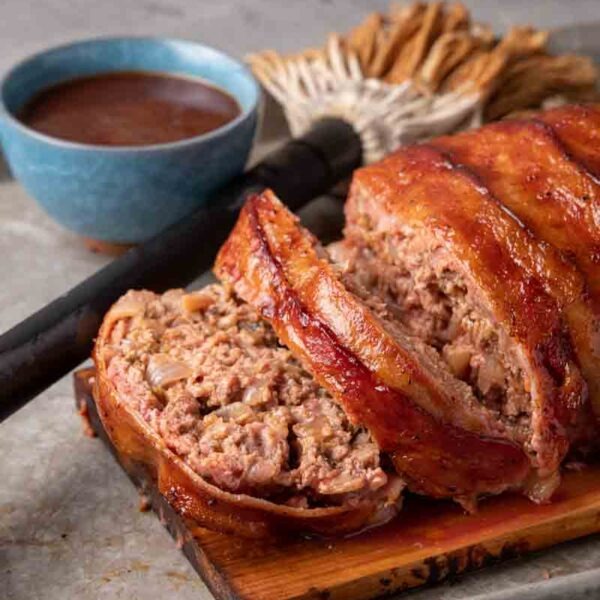
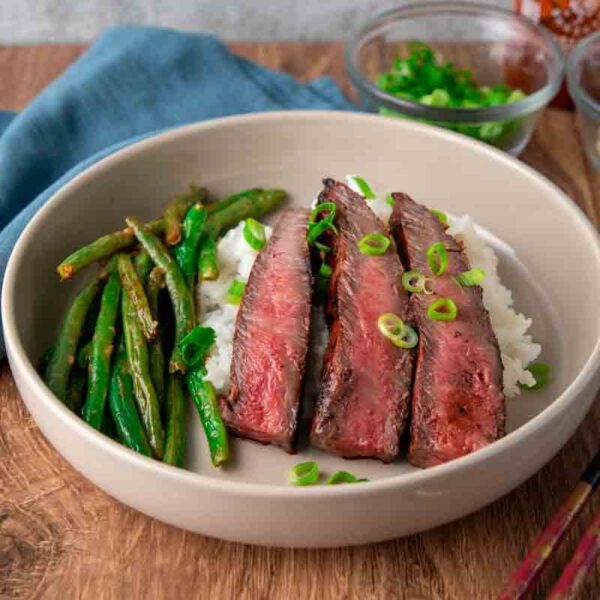
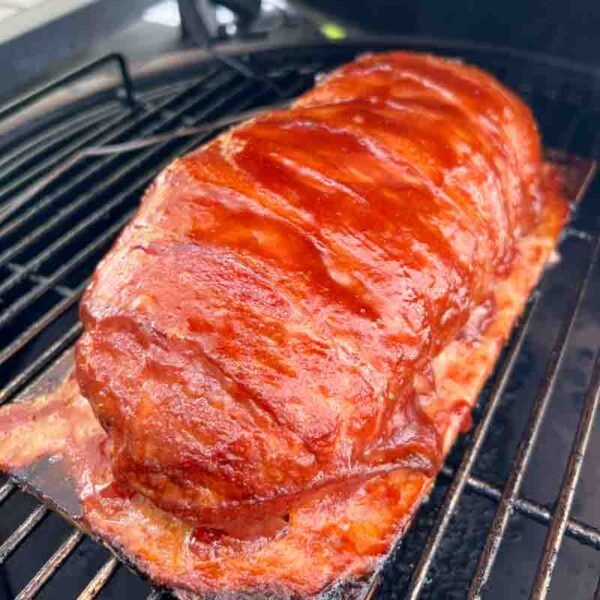
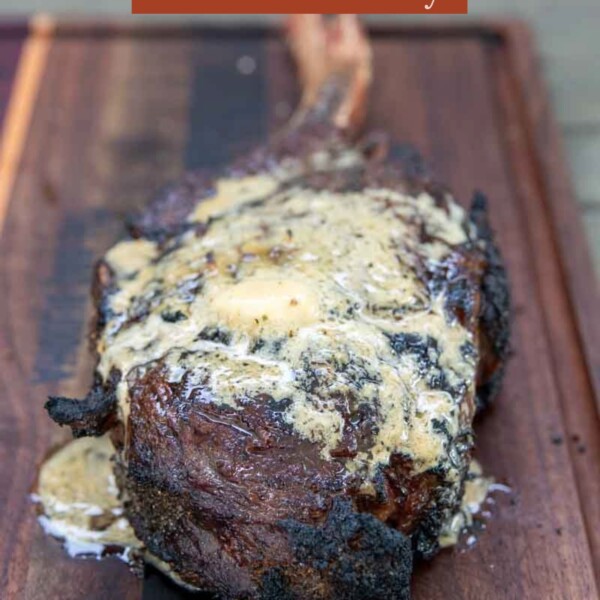




BBQ Buddha,
David here from Northern VA I am a BGE guy and am planning on another 10-12 lb Brisket smoke Sunday. I have smoked several briskets previously but I personally feel I’ve slightly missed the mark with them, they are good but a something is missing. I am really planning this smoke out but have a question for you, if I may please.
Several recipes advocate for cutting the Point from the Flat but cutting them either before the smoke or near the end. Have you heard of this, is there value in this, and do you recommend this technique? Any info would be very helpful and greatly appreciated.
Thanks.
Vr,
David
David thanks for reaching out. I have seen a lot of competition cooks separate the point from the flat. You can certainly do this and it makes it slightly easier to cook each muscle to the correct doneness. For me, it is too many moving parts and I try to keep the whole packer brisket in one piece during the cook for ease and presentation.
Chris,
Thanks for the quick response. I’ve just finished reading your recipe again but uninterrupted for the second time and will follow your process. Fortunately, I’ll be totally focused on this and am looking forward to my best brisket yet. Have a great day! Vr, David
Hi Chris,
I will be trying your recipe on my next brisket! I noticed that in the first description above it mentions to put the brisket in an aluminum pan after you take the brisket off the smoker after the cook. The recips says to also put the brisket in an aluminum pan after wrapping and putting back into the smoker in the aluminum pan. How should I handle that? Thanks!
Aluminum pan is a nice optional step. If you are able to use it then it helps keep the rendered fat in the pan helping to keep the brisket moist. If it doesn’t fit or you skip this step, you will be fine.
Chris, Great intel on this. I’m currently cooking my first. I’ve looked all over with no luck: When you place the wrapped brisket back in the smoker, do you maintain the 250F temp, or something else?
Thanks in advance! Al
You maintain the 250° temp. You’ve got this!
Chris, I’m going at this Brisket again and will let you know how it goes. One quick question; what kind of gloves are you wearing above?
Here you go… https://amzn.to/3Nib3lG
Chris everything here is so helpful. I’ve done 5-6 briskets and this is the first time I’ve learned about the chunk of wood to create a “bow”, how to get the BGE to 250 in a way to hold the temp so it doesn’t fluctuate too much, taking it to above 165 for bark formation, letting it sit for an hour to get to 165 before the move to the cooler and more! Great tips and I feel confident. My brisket is on its journey and I feel this will be the one! Thanks again.
Thanks for the kind words!
Hi Chris! Thanks for your recipe and tips on cooking a brisket on the BGE. I plan on using your recipe this weekend! Question: I have problems trying to keep the BGE at a consistent temperature when I am opening and closing it and adding more charcoal, spritzing, etc. The temperature drops and it’s hard to get it back up to the cooking temp which prolongs the cooking time and my frustration. What do you do to keep your BGE at a consistent temperature – or how do you get the temp back up after opening it? Do you use a fan in the ashhole? (I haven’t tried that yet.) Thanks in advance for your help!
Sometimes I use the fan with the Flame Boss or EGG Genius and that definitely fixes the issue. Best thing to do is make sure your temperature is set and stable for at least an hour before placing the brisket inside. I’be found once the BGE is stable opening and closing will not deviate the temp very much. Hope that helps!
Thanks so much, Chris! I’ll pay more attention to stabilizing it. Really appreciate your help.
BBQ Buddha,
Good morning. I have a small whole packer weighing ~8 lbs. would you cook it at a slightly lower temperature, say 225 degrees, vice 250 degrees? I don’t want it to get dried out, especially on the flat. I am planning on following all the other steps in the recipe as written.
Thanks!
David
Yes a lower temp would be helpful in your situation. Great call!
Hi Chris,
I have a 9.5 lb whole packer brisket and have friends coming over tomorrow evening to enjoy it. Of course I will need to make sure it’s done in time. My original plan was to cook overnight tonight on the Big Green Egg with FireBoard and fan temp control but wondering now if it might be better to cook throughout the day tomorrow so I’m not having to wake up throughout the night for all the different steps. When would you recommend I start the cook to ensure it’s done by around 6 PM?
Cheers
Tim
Hey Tim! I have a recipe for midnight brisket in my new book I’d be happy to email you. I lay out the timing to cook a brisket overnight so you don’t have to get up and mess with anything. Shoot me an email to chris@thebbqbuddha.com and I’ll respond with that recipe!
I’d love a copy of that, as well! I just emailed you.
Many thanks!
Chris, thanks for the lower temperature tip for the small Whole Packer Brisket. This turned out to be my best yet! Perhaps after several “ok” briskets – I’ve got it.
Have a GREAT 4th weekend.
Vr,
David
I’m so happy to read this! Thank you 🙏
Hey Chris, cooking a whole packer. 9.5lbs at 250. Struggling to find the best spot to place my digital thermometer. Getting readings already at 162F and it’s been 3.5hrs. Any thoughts? Bark is trying to grow.
You’re doing fine. Keep letting that bark form and don’t wrap until it looks good to you… even if the internal temp hots between 170-180°F. I always probe the flat as you know the point will have so much fat in it that it will be forgiving in the end. Hope this helps!
You’re the man! Thank you so much for responding. Happy 4th to you and yours!
For some reason just seeing this! Anyway, I always place temp probe in flat as that’s the most important part of the brisket to get right. Hope yours turned out ok 🙏
I’ve had my BGE for a couple of months and I’m getting ready to smoke my first brisket. I assume it’s done indirect with the convector in place, correct? Thank you in advance!
That’s correct! Youve got this!